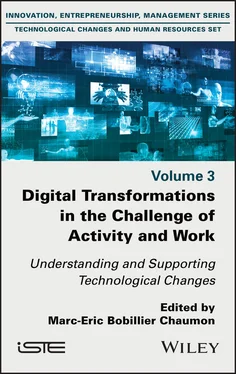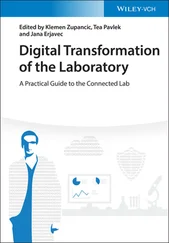Digital Transformations in the Challenge of Activity and Work
Здесь есть возможность читать онлайн «Digital Transformations in the Challenge of Activity and Work» — ознакомительный отрывок электронной книги совершенно бесплатно, а после прочтения отрывка купить полную версию. В некоторых случаях можно слушать аудио, скачать через торрент в формате fb2 и присутствует краткое содержание. Жанр: unrecognised, на английском языке. Описание произведения, (предисловие) а так же отзывы посетителей доступны на портале библиотеки ЛибКат.
- Название:Digital Transformations in the Challenge of Activity and Work
- Автор:
- Жанр:
- Год:неизвестен
- ISBN:нет данных
- Рейтинг книги:4 / 5. Голосов: 1
-
Избранное:Добавить в избранное
- Отзывы:
-
Ваша оценка:
- 80
- 1
- 2
- 3
- 4
- 5
Digital Transformations in the Challenge of Activity and Work: краткое содержание, описание и аннотация
Предлагаем к чтению аннотацию, описание, краткое содержание или предисловие (зависит от того, что написал сам автор книги «Digital Transformations in the Challenge of Activity and Work»). Если вы не нашли необходимую информацию о книге — напишите в комментариях, мы постараемся отыскать её.
Digital Transformations in the Challenge of Activity and Work — читать онлайн ознакомительный отрывок
Ниже представлен текст книги, разбитый по страницам. Система сохранения места последней прочитанной страницы, позволяет с удобством читать онлайн бесплатно книгу «Digital Transformations in the Challenge of Activity and Work», без необходимости каждый раз заново искать на чём Вы остановились. Поставьте закладку, и сможете в любой момент перейти на страницу, на которой закончили чтение.
Интервал:
Закладка:
As for the use of virtual reality in industry training, this mainly concerns maintenance and assembly. For example, the study by Abate et al . (2009) presents a head-mounted display application with a force feedback exoskeleton for maintenance training in the aerospace industry. In this study, users were required to perform eight routine maintenance tasks. Similarly, Stork et al . (2012) propose a semi-immersive system with a wide screen and natural interactions (to grasp objects with the hands) for assembly training in the automotive industry.
Virtual reality is also used to train operators in risk prevention. These applications are developing particularly in the construction sector. For example, Sacks et al . (2013) compared the effectiveness of safety training given by (1) a classroom trainer with a slide show with (2) training involving an immersive virtual environment used alternately by the trainer and the learners. The virtual reality system included a projection screen that allowed stereoscopic vision. The virtual environment represented a construction site. Learners were asked to share their general knowledge of the construction industry, identify risks in the situations presented and explain the behaviors to be adopted. In the same vein, the study by Zhao and Lucas (2015) presented a non-immersive virtual environment to sensitize workers to electrical risks. It allowed users to detect risks while navigating on a construction site. The virtual environment provided information to users on risks and on the behaviors to adopt.
3.6. Conclusion
Virtual reality is one of the technologies that is implemented today and that will continue to be implemented in the coming years in professional contexts. In this chapter, we have enlightened the reader on what virtual reality is and on the devices that virtual reality systems mobilize. We have also summarized its main applications, in general and more specifically in industry.
Most of the studies on the use of this technology, including the majority of those mentioned above, adopt technocentric approaches (or a Technology Driver approach, i.e. developing products that then seek to gain acceptance; Davies and Buisine 2017). Studies that adopt this approach describe only the technical characteristics of a virtual reality system or virtual environment, as well as their main objectives (training operators to identify risks, conducting studies on the interaction of a customer with a product, etc.). However, perhaps because the implementation of this type of technology in professional contexts is not democratized, or because they are only exceptionally integrated into employees’ activities, few studies have been carried out on their impact on work. However, their development raises questions about their suitability for users (usefulness, usability, acceptance), the changes they may bring about in the content of activities, as well as the health and well-being of employees. For these reasons, a user and activity-centered (anthropocentric) approach must be deployed to co-construct acceptable modalities for the deployment and adoption of these new immersive work environments.
3.7. References
Abate, A.F., Guida, M., Leoncini, P., Nappi, M., and Ricciardi, S. (2009). A haptic-based approach to virtual training for aerospace industry. Journal of Visual Languages and Computing , 20(5), 318–325.
Aromaa, S. and Väänänen, K. (2016). Suitability of virtual prototypes to support human factors/ergonomics evaluation during the design. Applied Ergonomics , 56, 11–18.
Benali-Koudja, M. and Hafez, M. (2006). Les interfaces tactiles. In Le traité de la réalité virtuelle , Fuchs, P. and Moreau, G. (eds). Les Presses de l’École des Mines de Paris, Paris.
Berg, L.P. and Vance, J.M. (2017). Industry use of virtual reality in product design and manufacturing: A survey. Virtual Reality , 21(1), 1–17.
Bernard, F., Zare, M., Sagot, J.-C., and Paquin, R. (2019). Using digital and physical simulation to focus on human factors and ergonomics in aviation maintainability. Human Factors , 62(1), 37–54.
Bordegoni, M. and Ferrise, F. (2013). Designing interaction with consumer products in a multisensory virtual reality environment. Virtual and Physical Prototyping , 8(1), 51–64.
Bruno, F. and Muzzupappa, M. (2010). Product interface design: A participatory approach based on virtual reality. International Journal of Human-computer Studies , 68(5), 254–269.
Burkhardt, J.-M. (2003). Réalité virtuelle et ergonomie : quelques apports réciproques. Le travail humain , 66(1), 65–91.
Coeugnet, S. (2018). Helping older pedestrians navigate unknown environments through vibrotactile guidance instructions. Transportation Research Part F: Traffic Psychology and Behaviour , 58, 816–830.
Davies, M. and Buisine, S. (2017). La culture d’innovation dans les organisations françaises. Technologie et Innovation , 2, 1–12.
tom Dieck, D., tom Dieck, C., Jung, T., Moorhouse, N. (2018). Tourists’ virtual reality adoption: An exploratory study from Lake District National Park. Leisure Studies , 37(4), 371–383.
Direction Générale des Entreprises (2016). Technologies clés 2020 : préparer l’industrie du futur [Online]. Available: https://www.entreprises.gouv.fr/politique-et-enjeux/etude-technologies-cles-2020.
Fang, T.Y. (2014). Evaluation of a haptics-based virtual reality temporal bone simulator for anatomy and surgery training. Computer Methods and Programs in Biomedicine , 113(2), 674–681.
Freeman, D. (2016). Virtual reality in the treatment of persecutory delusions: Randomised controlled experimental study testing how to reduce delusional conviction. The British Journal of Psychiatry , 209(1), 62–67.
Fuchs, P. (2006). Les interfaces à simulation de mouvement et les interfaces à simulation de climat. In Le traité de la réalité virtuelle , Fuchs, P. and Moreau, G. (eds). Les Presses de l’École des Mines de Paris, Paris.
Fuchs, P. and Mathieu, H. (2011). Location sensors. In Virtual Reality: Concepts and Technologies , Fuchs, P., Moreau, G., and Guitton, P. (eds). CRC Press, Boca Raton, Florida.
Ganier, F., Hoareau, C., and Devillers, F. (2013). Evaluation des performances et de la charge de travail induits par l’apprentissage de procédures de maintenance en environnement virtuel. Le travail humain , 76(4), 335–363.
Gavish, N. (2013). Evaluating virtual reality and augmented reality training for industrial maintenance and assembly tasks. Interactive Learning Environments , 23(6), 1–21.
Gomes De Sá, A. and Zachmann, G. (1999). Virtual reality as a tool for verification of assembly and maintenance processes. Computers and Graphics , 23(3), 389–403.
Gosselin, F. and Andriot, C. (2006). Les dispositifs matériels des interfaces à retour d’effort. In Le traité de la réalité virtuelle , Fuchs, P. and Moreau, G. (eds). Les Presses de l’École des Mines de Paris, Paris.
Guo, X. and Yang, G. (2013). Animating prairies simulation with shell method in real-time. Journal of Software , 8(12), 3166–3172.
Hamid, N.S.S., Aziz, F.A., and Azizi, A. (2014). Virtual reality applications in manufacturing system. Proceedings of 2014 Science and Information Conference , 1034–1037.
Helbig, C. (2014). Concept and workflow for 3D visualization of atmospheric data in a virtual reality environment for analytical approaches. Environmental Earth Sciences , 72(10), 3767–3780.
Hsu, S.Y. (2017). Three-dimensional, virtual reality vestibular rehabilitation for chronic imbalance problem caused by Ménière’s disease: A pilot study. Disability and Rehabilitation , 39(16), 1601–1606.
Читать дальшеИнтервал:
Закладка:
Похожие книги на «Digital Transformations in the Challenge of Activity and Work»
Представляем Вашему вниманию похожие книги на «Digital Transformations in the Challenge of Activity and Work» списком для выбора. Мы отобрали схожую по названию и смыслу литературу в надежде предоставить читателям больше вариантов отыскать новые, интересные, ещё непрочитанные произведения.
Обсуждение, отзывы о книге «Digital Transformations in the Challenge of Activity and Work» и просто собственные мнения читателей. Оставьте ваши комментарии, напишите, что Вы думаете о произведении, его смысле или главных героях. Укажите что конкретно понравилось, а что нет, и почему Вы так считаете.












